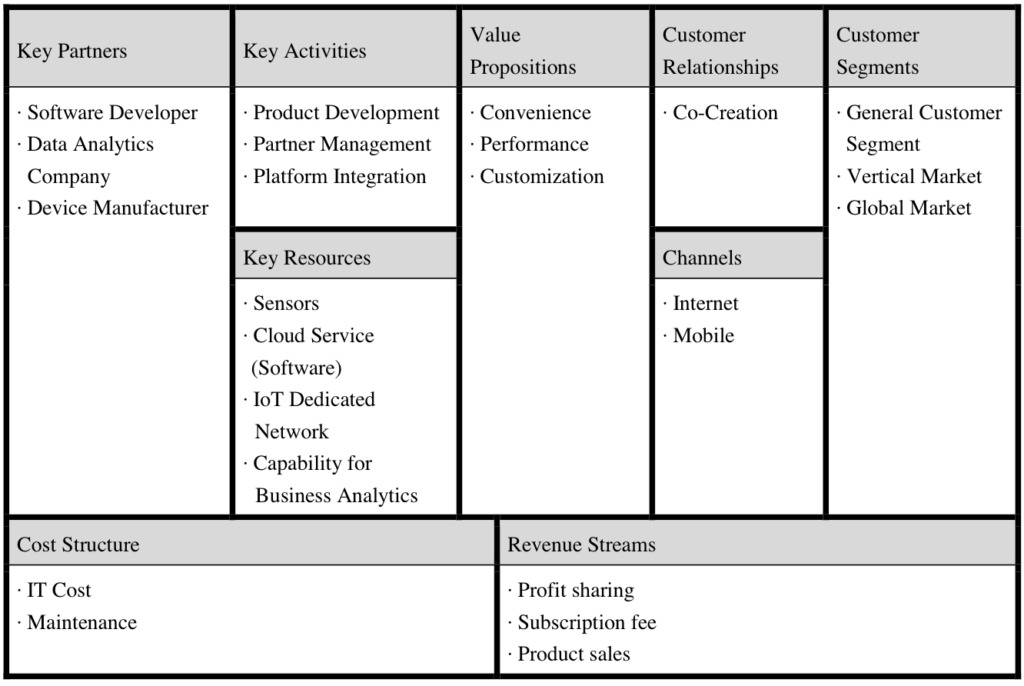Category: Business Creation
(9 von 100)
Why: We want to identify which part of the business model we should be focusing on to innovate our IoT Service quickly and effectively.
Business model is a building block that characterizes a company. How it creates values and delivery it, while making profit.
Here is what you should look out for!
Table of Contents
In Short
The Internet of Things (IoT) has been steadily emerging and gaining traction over the past decade. However, despite its potential, it still remains in its infancy in terms of practical applications. As a result, the majority of IoT-based business models are currently limited to specific industries and contexts, where its transformative potential is being harnessed to its fullest extent. Nonetheless, with ongoing advancements and innovations, the IoT is poised to revolutionize various sectors, offering unprecedented connectivity and automation that will reshape the way we live and work.
The task is to look at the underline capability of IoT technology and see which part of the business model we should really be considering.
1. Connectivity brings Complexity
The most prominent characteristic of IoT is that it connects EVERYTHING together. The standard vertical value chain is no longer valid. There is so much more synergy between ‘things’ to be discovered.
Furthermore, Internet of Things (IoT) connectivity plays a crucial and influential role in integrating processes across various domains. It provides the surprising capability of enabling cross-company or cross-industry process integration, which in turn fosters collaboration with other entities, including competitors. This opens up new avenues for innovation, knowledge sharing, and the collective advancement of industries as a whole.

If you are working on a lean project for a process in your company, you might not want to hear about IoT. Because we are just exposed to technology, we are collecting much garbage and leaving out possibly a lot of gold. Wasteful…
2. Business model
Generally, we aim to model our business to minimize the cost structure and maximize profit capabilities. The main elements in the model are as follows.
- Customer value proposition
- Profit model
- Value chain
Practices such as the business model canvas are widely utilized by entrepreneurs and business professionals to establish strong connections between the fundamental elements of a business. This strategic tool enables the identification and alignment of key components, including partner and resource infrastructure, value creation processes, target customers and effective channels, as well as the financial aspects required for sustainable growth and success. By providing a holistic view of the business landscape, the business model canvas facilitates informed decision-making and empowers organizations to adapt and thrive in dynamic market environments.
3. IoT Values
The values of IoT connectivity lie in convenience, performance, customization, sharability.
The question is, what difference does IoT bring to the business model innovation.
During our engaging and insightful discussion on the intricacies of working across diverse domains and the fundamental building blocks of business, it became apparent that while customers and financials remain consistent pillars, there have been notable shifts in our key partners and the processes involved in value creation. These shifts reflect the dynamic nature of the business landscape, highlighting the need for adaptability and a proactive approach to stay ahead in today’s ever-evolving market.
The key factor of IoT service has always been data collection from sensors and data analysis in the cloud server. How you progress with data is at the core of IoT value creation. Therefore, we should focus on value propositions, key partners, key activities, and key resources from the business canvas.

Result
In the era of the Internet of Things (IoT), the interconnectedness of devices and systems calls for seamless collaboration across diverse domains. As we embark on this transformative journey, it is crucial to acknowledge that this interconnectivity brings with it a heightened level of complexity in all aspects of our future business landscape. To navigate this disruption successfully, effective risk management strategies become paramount, ensuring resilience and adaptability in the face of evolving challenges and opportunities.
Today, we looked at why IoT affects how we run business and where our business should we be looking to adapt and strive with the technology. The study from Kim and Ahn suggested that we look at the underlying differences of key partners, activities, resources, and the value proposition.
Reading material: Ju, J., Kim, M. S., & Ahn, J. H. (2016). Prototyping Business Models for IoT Service. Procedia Computer Science, 91, 882–890. https://doi.org/10.1016/J.PROCS.2016.07.106


Pingback: Definitive Guide To Smart Services (2024 Updates)